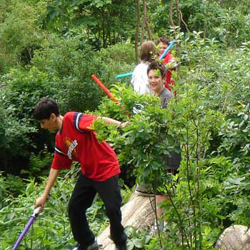Professional Practice
Children: Stress

According to the Anxiety and Depression Association of America, one in eight American children are affected by anxiety disorders. These children are at a higher risk for poor performance in school, and have an increased risk of substance abuse.
How Nature Helps
Research published in Environment and Behavior has shown that access to nearby nature acts a buffer to these stresses, especially in children. Time spent outdoors and immersed in nature helps to relieve anxiety and stress, putting children in a more relaxed mindset, where they can focus and learn more effectively.
In a children’s hospital setting, one study in the Journal of Environmental Psychology found that patients who spent time in the garden reported lower stress levels and higher levels of hope and energy.
Research
"Nearby Nature: A Buffer of Life Stress among Rural Children," Environment & Behavior, 2003
“Evaluating a Children’s Hospital Garden Environment: Utilization and Consumer Satisfaction,” Journal of Environmental Psychology, 2001
 ASLA 2009 Professional General Design Honor Award, Teardrop Park, NYC, Michael Van Valkenburgh Associates, Inc. / Image credit:
ASLA 2009 Professional General Design Honor Award, Teardrop Park, NYC, Michael Van Valkenburgh Associates, Inc. / Image credit:
Elizabeth Fellicela
Organizations
Outdoor Nation
The Student Conservation Association
Outward Bound - Intercept
Role of the Landscape Architect
Landscape architects provide refuge from day to day stress by designing small intimate spaces that allow us to relax – these small pieces of nature are important to children, and everyone.
Tear Drop Park has ample opportunity for children in nearby apartment buildings to play and explore, as well as feel soothed by the trees and water.
Tiny plazas like Central Wharf Plaza are equally important, providing opportunity for respite in the form of shade from tree canopy and seating.
Case Studies
Tear Drop Park, New York City, New York, Michael Van Valkenburgh Associates, Inc.
Central Wharf Plaza, Boston, Massachusetts, Reed Hilderbrand
<< Obesity
Type II Diabetes >>